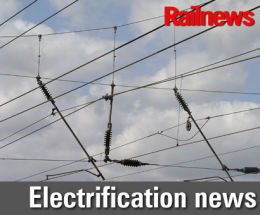Posted 18th July 2016 | 5 Comments
Great Western switches on

THE first stretch of the Grest Western Main Line electrification beyond Reading was energised and tested over the weekend of 16-17 July.
A Hitachi Class 800 intercity express ran successfully between Reading and Didcot on the mornings of Saturday and Sunday up to line speed (125mph/200km/h) in a series of exercises designed to test the new OHLE.
The Reading to Didcot stretch has been completed first as a testing ground, although the project as a whole is running late, while its costs have risen sharply. The GW electrification has been given priority over the Midland Main Line, because new IE trains for Great Western are now being built, and the Department for Transport was concerned that new electric trains could arrive before the line was ready for them, triggering substantial leasing charges which would have fallen on the taxpayer.
Another fleet of intercity express units has been ordered for the East Coast Main Line between London, Leeds and Edinburgh, but this route was electrified in the 1980s.
Network Rail GW route director Mark Langman said: "This is a great step forward, and I’d like to pay tribute to the team who have worked very hard to make this happen. This is the future of rail being built before our eyes and it’s a very exciting time to be involved in this project. This weekend we’ve come a big step closer to providing faster, quieter, and more efficient services to the people of the region who depend on railways.”
Reader Comments:
Views expressed in submitted comments are that of the author, and not necessarily shared by Railnews.

John Gilbert, Cradley, Herefordshire
What a total mess the whole GWML scheme is. It is to be hoped that the Midland Main Line scheme will revert to the light-years-simpler system of OHLE used on the East Coast, which has now, pace Roger Ford in 'Modern Railways,' had its gremlins dealt with.
James palma, London.
It was two units, 800001 and 800002, running off the overhead apparently but between reading and dicot where the overhead is on.
Tony Pearce, Reading
As I am 'miffed' at missing this important development at my local Station I have been down to see my Railway Oracle - otherwise known as the Ticket Office Clerk at Tilehurst. 'No Test Trains been through here', he said and pointed to the complete absence of any wires on the slow tracks through the Station. As there are no wires just further down the fast tracks on the new 2 mile flyover to the west of Reading Station, he may have a point. So was the train used one with a Diesel engine as well ? And exactly between which stations did it run because I can't work out a route between Reading and Didcot which would have had electrification all the way.
Derek Rimington, Brighton
Mr Editor, your photo suggests a Headspan system has been used for the Great Western. I understood that full portal frames were being provided to increase reliability.
[It's a stock shot of OHLE from our web library. It's not meant to be a precise illustration. Time presses...--Editor.]
Tony Pearce, Reading
I thought I heard something new on the line on my early Daily Walk near Pangbourne over the Weekend. The trouble is that for 'Train Spotters' the River Thames is nearby and for the first few hours in Summertime Mornings the river and line are covered with a mist which sits in the Valley obscuring everything including all the tracks. However the Electrification does not extend on the Main Lines on Reading Viaduct between it and Tilehurst, although the 'slow' lines do now seem to be completed.